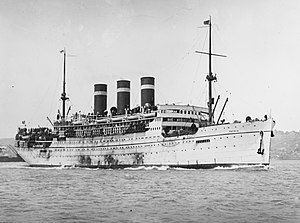 Patria photographed in 1918-1919, while transporting American troops
| |
| History | |
|---|---|
| Name | SS Patria[1] |
| Namesake | patria, Latin for "fatherland" |
| Owner |
|
| Operator |
|
| Port of registry | |
| Builder | Société Nouvelle des Forges et Chantiers de la Méditerranée[1] |
| Launched | 11 November 1913[2][3] |
| In service | 15[2] or 16[3] April 1914 |
| Out of service | 25 November 1940 |
| Identification |
|
| Fate |
|
| General characteristics | |
| Type | Ocean liner |
| Tonnage | |
| Length | 487.2 ft (148.5 m)[1] |
| Beam | 59.2 ft (18.0 m)[1] |
| Draught | 40.1 ft (12.2 m)[1] |
| Installed power | 900 NHP[1] |
| Propulsion | twin screws powered by two triple expansion steam engines[1] fed by nine boilers[2] |
| Speed | |
| Capacity | |
| Crew | 130[3] |

SS Patria was an 11,885 GRT French ocean liner built in 1913 for Compagnie française de Navigation à vapeur Cyprien Fabre & Cie (Fabre Line), for whom she was first a transatlantic liner and then an emigrant ship. From 1932 Fabre Line leased her to Services Contractuels des Messageries Maritimes, who ran her between the south of France and the Levant. After the fall of France in June 1940 the British authorities in Mandatory Palestine seized her in the Port of Haifa and placed her under the management of the British-India Steam Navigation Company. In November 1940, the Zionist movement Haganah planted a bomb aboard which sank her with the loss of between 260 and 300 lives. Patria remained a wreck in Haifa port until she was scrapped in 1952.
- ^ a b c d e f g h i j k l m Lloyd's Register of British Shipping. London: Lloyd's Register. 1930.
- ^ a b c d e Ramona, Philippe. "Le Patria". L'Encyclopedie des Messageries Maritimes (in French). Philippe Ramona.
- ^ a b c "Paquebot PATRIA". French Lines (in French). 1998–2013. Archived from the original on 2012-12-16.
- ^ Lloyd's Register of British Shipping. London: Lloyd's Register. 1940.
- ^ a b Antinoro, Carmelo (2008). "Favaresi Emigrati in America". Memorie storiche di Favara. GeneoStoriaFavara. Retrieved 30 March 2013.